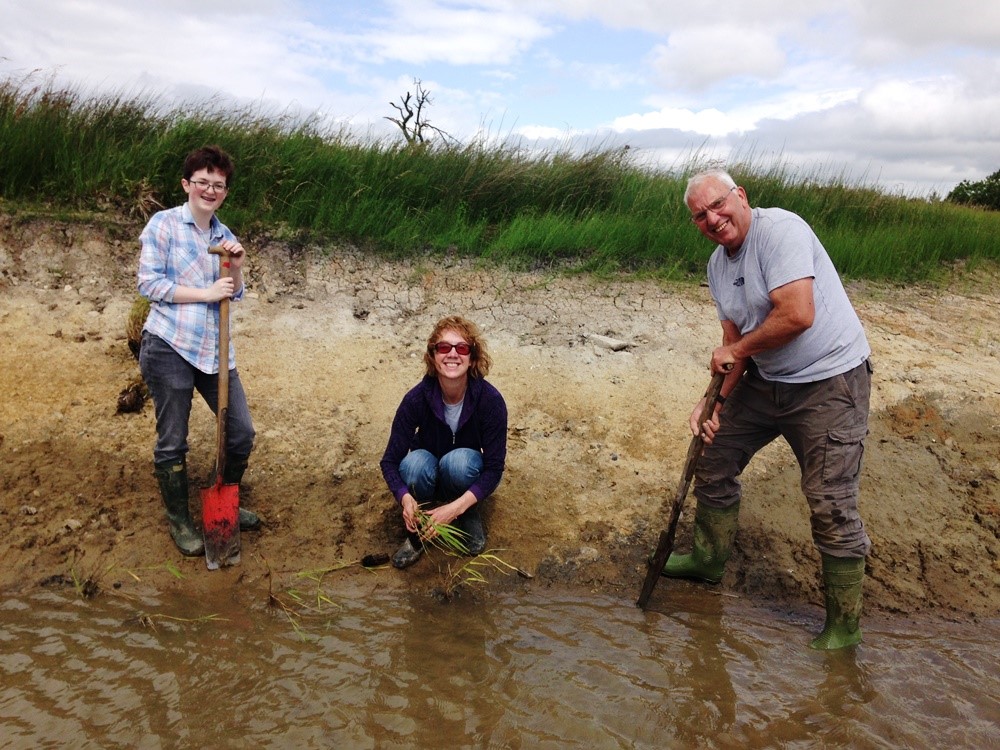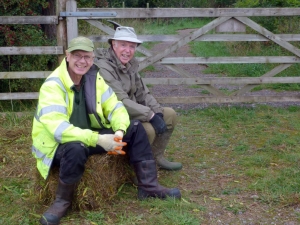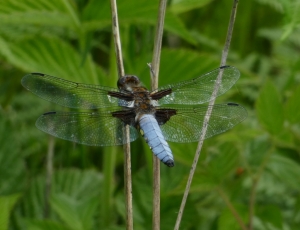Blog Archive (27) Posts Made in October 2017
More Wetland Work
Tuesday, October 31st 2017
Volunteers were back on the wetland today.
.jpg)
By the end of the day you could see the differeence that has been made.

Elsewhere some of the moorland was being strimmed.

Although a dull day, the autumn colours still shone through.

Larch is just beginning to turn yellow.

Thank you to everyone who helped today.
Boxes and Ponies
Monday, October 30th 2017
It was mentioned on the blog last week that some owl boxes were being built for us. These are being given to us to help the work that we do with owls at Foxglove and out on the training area.
The building where the boxes were being made was well organised with everything prepared to enable the boxes to be put together easily. These are Little Owl boxes.

Barn Owl boxes are also being made for us.


A different topic now. Yesterday I watched the ponies at work. Lark began pawing the ground and I realised that he was attacking some Gorse. He continued until he had broken some of the stems and then he ate it. I was so busy watching in amazement that most of the Gorse had been eaten before I took a photograph.

But not quite, if you look closely you can just see the last remnants of it.

I must admit today they were both eating the grass, a change from the Gorse I suspect. Taurus had a drink and then tried to blow bubbles at me! I am sure both are well settled on our heath.

Change of Birds
Sunday, October 29th 2017
As the summer turns to autumn, so the birds coming to the ringing room also change. Chiffchaffs have now all headed south. Redpolls and Coal Tits begin to return to Foxglove. The first of the winter migrants arrive and Brambling and Redwing were ringed today.

Whilst working and walking on the reserve Kestrels have been spotted. A young male was newly ringed today. We may see its ring whilst it searches for food over Foxglove.

Many visitors came to the ringing room and were enthralled at seeing the birds close up whilst the process of ringing was explained to them.

Most unusually a Marsh Tit and a Willow Tit were ringed together so the differences could be highlighted. The Willow Tit is farthest away, the Marsh Tit is at the front.

A retrapped Coal Tit was found to be 4 year old and a tiny Goldcrest was first ringed as a juvenile in October 2015. Other species ringed today included Bullfinch, Greenfinch, Nuthatch, Treecreeper and Redpoll.
Flying overhead were Sparrowhawks and John photographed this one.
.jpg)
The sun shone most of the day and there were still some Common Darters sunbathing!

Thank you to everyone who helped today.
Halloween!
Friday, October 27th 2017
A lovely sunny day for a walk to collect natural objects to decorate witch's hats.
Back in the Activity Room spiders were made.
Bats were next on the list.
There were fearsome cakes to go with their drinks. And to end the activity a display of all the things that had been made, spiders and webs, mobiles and hats!
A great, spooky Halloween morning for everyone. Thank you to those who helped today.
More Work, More News
Thursday, October 26th 2017
Work continued on the wetland and you can see the difference already.


Meanwhile other volunteers were preparing for tomorrow morning's Halloween activities. Sculthorpe Moor Nature Reserve (part of the Hawk and Owl Trust) are making us over £2500 worth of large nest boxes and they are actually being made now. And towards the end of the day the Exmoor Ponies arrived.

They are called Taunus and Lark. It did not take them long to start and feed. They are on the heath to eat the invasive species and they must not be hand fed.

Thank you to everyone who helped today.
Thank you also to those people who have voted for us on the Aviva Community Project 2017.
Owl Pellet Discovery
Wednesday, October 25th 2017
Children and parents arrived this morning ready to tackle some owl pellet dissection. Armed with owl pellets collected during the summer and autumn by the bird ringers, the children began their delve into another world. What had the owls been eating?

It did not take long before the parents were helping! Some of the bones required a closer examination.

Once the bones had been found they were mounted on card to be taken home. You can see that this owl had consumed voles, mice, a shrew and possibly a mole. It is known that shrews and moles taste rather unpleasant.

This was another excellent activity where the children learnt about owls and their food. Looking at the observation board and the photographs on display the children asked questions about birds and moths. One little boy was off to find out more about shieldbugs, as he has seen several around his school.
It was the last Wednesday of the month, so that is Flower Walk morning. Our route included Risedale Beck, down to the lake, up the Syacamore Avenue, across the moor and through the Scrapes. Although we found nearly 30 flowers open, passing the flower test, their numbers are much reduced. Some had to be examined closely.

Surprisingly Cross-leaved Heath was still flowering.

And to brighten up the blog there was a Dandelion in flower!

We have said many times that our volunteers have a great variety of skills and today was no exception. Some helped with the children's activity whilst others carried out the flower walk and identified moths. Thank you to everyone who helped.
Something New and Work
Tuesday, October 24th 2017
Over the years there have been many varied projects carried out at Foxglove, funded by grants. The Cascading Pools provide different habitats for many species.

Things look a little different now!


Our Touchscreen was 'opened' in December 2014 and has been a great success.

And of course our very special wetland was developed with grants in the winter of 2008. Volunteers have been clearing some of the ponds and today the vegetation was removed after allowing any 'bugs and beasties' to crawl back into the water.

A grant assissted us to plant Yellow Rattle plug plants across the moor and the results have been spectacular.

Plover's Pool was another project.

Many other developments have been carried out with the help of grants. You will notice at the top of the blog a new header, the Aviva Community Fund 2017. We have applied for and progressed through several rounds to get this far, but now we need your help. Please follow the links and vote for Foxglove so that we can gain a grant to help with conservation work. Thank you very much.
Work continued today checking and if necessary removing or replacing tree tubes.

Many thanks to the volunteers who carried out a great deal of work today.
Awesome Autumn
Monday, October 23rd 2017
Autumn is showing off with all her autumn colours. Leaves are turning from green to reds, yellows and oranges.



Today was the first activity of half term and the children were looking at autumn. They found out how plants and animals use this time of year to prepare for winter. Plants produce seeds which will germinate in the spring. Deciduous tree leaves change from green to red, yellow, orange and brown then fall from the branches. Some butterflies feed on the few flowers still open and then find a suitable place to hibernate. Pond Skaters use some of the log piles to hibernate. Amphibians also choose log piles, holes in the ground or sometimes even the mud at the bottom of a pond in which to spend the winter. Roe Deer have fed well during the summer and have grown fat. Their coats have grown thicker to protect them from the winter chill.
The children looked for the colours of autumn.

They displayed their finds.

News and Information
Sunday, October 22nd 2017
Firstly some news. On the blog of the 11th October, there was a photo of an unco-operative fungus. It transpires that it is called Redleg Club, Typhula erythropus. Chris, who guides and helps us with our fungi, took it to show the NE Fungus Study Group. They were fascinated by it. Tom Kirby said it was a significant find and Chris has sent an official record, via him, to the BMS (British Mycological Soc.) database. Thanks go to Pauline who actually found this tiny specimen.
.jpg)
Talking of tiny specimens Dr Roger Key is holding a training course for Friends and volunteers on Invertebrates on the 1st November. If you are interested then please look at our events page for more details.
And on a totally different track it is our Worky Day on Saturday 4th November and our Coffee Morning on Thursday 9th November. Again there are more details on the events page.
I ended the blog yesterday with an artistic photograph. This one is more colourful, with red Hawthorn Berries against the yellow and grey lichens.

Looking through others that I took, I rather liked this one. Some fungi and a single Rose Hip.

Fun Photography
Saturday, October 21st 2017
Driving into the reserve I saw the Redwings at the Stone Pile, their usual place, due to the Hawthorn trees heavy in fruit. The photographs that I took are now in the recycle bin. The Redwings were totally unco-operative. A plan was hatched - creep up on them from behind the bus shelter. Yes they were still there and yes the photos are in the recycle bin, except one, which to my great surprise, actually shows a Redwing in reasonable focus, even if it is behind branches and stems.

A beautiful Redpoll feeding on the Nyger seed feeder outside the kitchen window fared no better in a photograph, but at least I had the excuse of it being taken through the window in the rain. Two Great Spotted Woodpeckers were feeding on the peanuts until one decided to chase the other away. Other birds in the back garden included male and female Bullfinches, Goldfinches, Siskins, Coal Tits and I think a Marsh Tit.
After failure with the birds I decided that I would concentrate on the invertebrates, hoping I might find a slug or two. But what a walk. Firstly I was threatened by a looper caterpillar as it looped its way along the fence. Loop and

unloop and stretch!

Then there was the shield bug with long antenna sitting most comfortably on the seed head of Lesser Burdock. It was also sporting a drop of water right at the tip of its wings, or should that be abdomen?

A brightly coloured Bronze Shield Bug, final instar, caught my eye.

How many insects can land and feed on an Ivy flower? The whole Ivy shrub was covered in a myriad of insects.

And finally a bit of artistic photography.

CES and the BTO
Friday, October 20th 2017
CES and BTO are often mentioned in the blog. CES is our Constant Effort Site Scheme, where we put up the same nets for the same length of time, ten and a half hours, for 12 days during the summer. The BTO is the British Trust for Ornithology and we send all our data to them, as do other CES sites.
We received a thank you from the BTO.
'Thank you very much for your CES submission. I am really pleased that you had such a decent season for juveniles, although it must have been a little disappointing that your adult numbers were quite low in comparison to your normal totals (lower than they have been since 2003 in fact!). It is a real testament to you and your team's dedication that your CES have been running so consistently and so successfully for so long.'
This made me go back and look at some of the photos taken during CES in 2017.
Sunrise in August.

Many different species of birds arrived in the ringing room.
A juvenile Robin just starting to get its red feathers, including some tiny ones around its beak and face.
.jpg)
Reed Buntings were scarce but some were ringed.
.jpg)
A Tawny Owl was also caught.

And of course there were other species to be looked at and photographed.
A Northern Marsh Orchid.

Yellow Rattle was in full flower on the middle moor.

And of course not forgetting some of the creepy crawlies that posed beautifully for their photograph to be taken. A Cucumber spider.

The preliminary results of CES will be published towards the end of November and the full trends will be produced in the new year.
None of this would have been achieved without the sacrifices and long hours, a 4am start in June, each of the bird ringers put in during 2017. Many thanks and well done to them all.
A Very Wet Task
Thursday, October 19th 2017
Foxglove volunteers were busy clearing out the excessive growth of Bulrush and Branched Bur-reed from some of the wetland ponds. If these plants were not removed then the ponds would become totally overgrown providing a suitable habitat for other species like willow to grow. Our wetland ponds are very special and require much work to ensure they retain their unique flora and fauna. This is not an easy task and a rather messy and muddy one.
.jpg)
As the day progressed so the amount of water to be seen increased.
.jpg)
By the end of the day the pond looked like a pond again.
.jpg)
Thank you very much for all your hard work.
There was a surprise visitor to the moor, in the shape of a very handsome Swaledale tup. Not all of the ewes looked impressed.

Varied Work
Wednesday, October 18th 2017
It has been said many times before that Foxglove Volunteers have a huge range of skills. Yesterday some were carrying out habitat management and mending the potholes in the road. Early today the Water Voles were fed and the pond dipping sinks were cleaned, then some stock was checked in preparation for new charts to arrive.

Colin was edging the lawns outside the Field Centre.

And later in the day a 'rooting' walk unearthed more fungi, flowers and even some invertebrates.

We discovered, and I hope I have the name correct, this beautiful Turkey Tail fungus.

There were several visitors walking around the reserve enjoying the autumn colours. Buzzards were circling overhead. A variety of species of bird were feeding in the back garden and the Kestrel was sitting high in a tree on the heath, as we left in the early evening.
At lunchtime Foxglove was visited by Colonel P Cook AAC, Deputy Head Ops/Plans/Safety, Mr J Crosfield, Deputy Head UK Delivery, both from HQ DIO SD Trg and Mr S Utley, Managing Director of Landmarc Support Services. They were able to take a short walk through the reserve and visit the Field Centre before lunch. During lunch they talked to the volunteers about the role they played and about Foxglove's place in the community, both military and civilian. Our visitors were very impressed with what they had seen and heard.
Thank you to everyone who helped today, in so many different ways.
A Fungi Walk
Monday, October 16th 2017
Wetherby U3A was taken on a guided walk, by Chris, looking for fungi. Fly Agarics were showing off their beautiful red colour. The moor edge is a mixture of moor and conifer as they abut onto each other, so we get a mixture of fungi favouring conifer wood conditions and moor edge conditions, which makes life interesting.
When the fruiting body of Fly Agaric first begins to develop it is a small, almost totally white ball. When we first spotted these in abundance we were excited that it was a new species, but over the next few days were just as pleased to see them develop into one of our favourite fungi.

The group were amazed at the number all growing in the same place. Fly Agarics usually prefer the conifer woodland areas in which to grow. However this bit of moor is influenced by the conifers.

You can just see the edges of the yellow skirt.

Thanks to Chris who led the walk. Everyone enjoyed themselves and they plan to return next year to look for flowers.
Exploring, Learning and Discovering
Sunday, October 15th 2017
Autumn has brought a splash of vibrant colour to the reserve.

An enthusiastic group of young nature detectives headed to the outdoor classroom to see what they could discover in the Autumn sunshine.

They began their morning by playing a searching game to get their 'nature detective eyes' working.

They found the bright animals easier to find than the dark camouflaged ones, this was lots of fun!

They then set out on a proper minibeast safari and found lots of real animals to study.
.jpg)
On the forest floor were beautiful fungi as well as plenty of invertebrates.

The children found millipedes, harvestmen spiders, earthworms (aplenty) and this stunning shield bug which was well camouflaged!

Walking back they made their own 'human millipede' and discovered that it was quite tricky to walk in a straight line!

Thank you to all of the intrepid mini explorers for being so keen and enthusiastic and to their parents for their support.
A School Visit and a Goodbye
Saturday, October 14th 2017
Carnagill Community Primary School visited Foxglove on Friday. The weather was kind and the children were able to hunt for minibeasts. They had spoons and dishes to collect their finds and magnifying glasses already to examine them.

Minibeast hunting.


Dexter Cattle have been on the wetland to help with habitat management since July. We have said good-bye to them, now and they have returned to Big Sheep Little Cow. Thank you letting them spend the summer with us.
Checking the cattle last week I was initially concerned that I could not see the calf but then spotted her in the an area of long grass.

Meanwhile the two adults were having a brush and clean up before heading home.

Keeping Your Eyes Open
Friday, October 13th 2017
Firstly, after getting excited about the caterpillar yesterday, I have to report that it is more likely to be a Ruby Tiger caterpillar than a Muslin Moth.
Along Risedale Beck our Daisy patch still has Daisies growing.

Bracken changes colour to orange and brown but many ferns remain green right through until spring.

Phragmites flowers very late in the year and has recently changed from the dark purple red to a more grey red colour as the stamens and stigmas have developed. It is lovely to walk through the reeds and listen to the swishing sound they make and sometimes to hear Reed Buntings and Moorhens who live there.

Throughout the winter on sunny days the Whirligig Beetles can be seen on the ponds, but not so the Pond Skaters. Over the last week they have disappeared, obviously heading to their hibernation sites, for the winter, where they tuck up their legs to prevent them from being damaged. In amongst the dead stems of the water plants the orange seeds of Yellow Iris are obvious.

One Thing and Another
Thursday, October 12th 2017
Caterpillars are not the easiest of species to ID. Sometimes even ones with bright dots and lines and splodges are difficult to pin down. This plain brown hairy one, with lovely pale claspers, has been seen walking across paths and boardwalks in recent weeks, and has been rescued! A search seems to indicate that this is a Muslin Moth caterpillar, which feeds on docks and chickweed. According to our records we have never caught the adult moth. The male is pale grey in colour whilst the female is white. A little more investigation is needed to confirm this ID.
.jpg)
A couple of days ago the Spindle fruits were closed but now they have burst and the orange covered seeds are visible.

On one of the logs close to the Field Centre Lycogala terrestre is growing. This slime mould is orange as it begins to grow.

But ages to a dull brown.

Also on the log is a tiny minature garden. Lichen and mosses are growing together.

Most of the Blackberries have disappeared by now, eaten by many voles, mice and birds. White Blackberry flowers can still be seen but these rarely develop into fruits.
.jpg)
Unco-operative Moths!
Wednesday, October 11th 2017
I checked the weather forecast and decided that the wind was reasonable and that it would not blow the trap away overnight, but I did put a stone in it, just in case. Driving down to Foxglove this morning with the trees blowing ferociously I wondered where the moth trap would be. Thankfully it was where I had left it.
It was a mild night and I did have hopes of a good catch, but there were only 6 moths in the trap. Two Red-green Carpet moths were recorded. When released from the pot on to the wall one of them disappeared into a space. The other released on the wood pile, stayed without moving but would not open its wings.

A Green-brindled Crescent took us a considerable time to ID. We thought we had found it but it only lived down south, another one we thought it might be only flew in June. Suddenly we all 'found' it. It was dull and lighting conditions not good for photography and made worse by the fact that the moth decided to head into the undergrowth, followed by three cameras! Believe it or not there is green on this moth although it is not shown on this photo. The photo that does show the green is not in focus! If you squint a little you may imagine a tiny bit of green on the wing.

Some visitors were enthralled by the reserve and our moth trapping and joined us when we were taking photographs. The moth the gentleman is focusing upon sat still beautifully for him. It moved when I tried to take it.

Although only 6 moths in the trap, it was full of midges, a wasp, caddis flies and we think, Ichneumon deliratorius. The female has bands on her antennae, which this one does have. And interestingly it attacks moth larvae. The downside to our ID is that one web site reports the adults are to be found in July. Photos will be forward to an expert for confirmation and if it is confirmed then it is yet another a new species for the reserve.

Change of subject, but still unco-operative, in that I had to use the table as a background to get a photograph. Chris and Pauline went out fungi hunting and found 25 species. Some fungi are large, some colourful, some aromatic but I am not sure which category this one comes into. As yet name unknown!

Birds
Tuesday, October 10th 2017
The lake appeared quiet, but a closer look revealed Moorhens feeding and Mallards just deciding to head off the tree. They created a large bow wave.
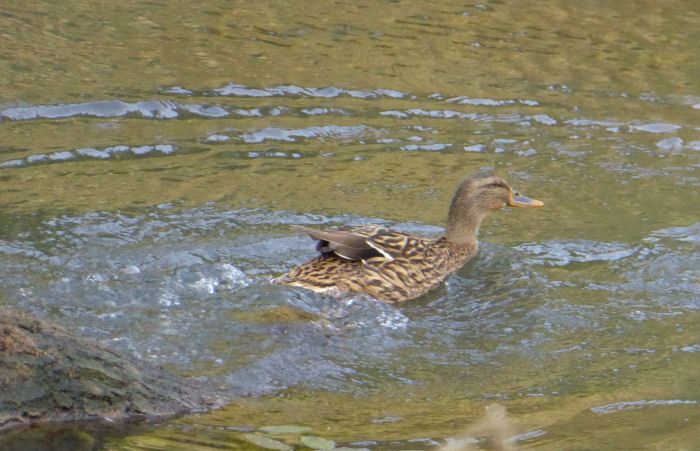
In the distance, a juvenile Little Grebe was feeding. There it was and then it wasn't!
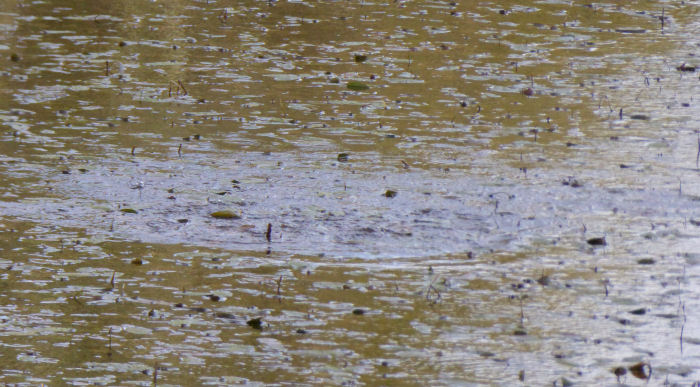
Listening to the different bird song on the reserve made me wonder what was around this time, last year. We were ringing and Brambling were caught.
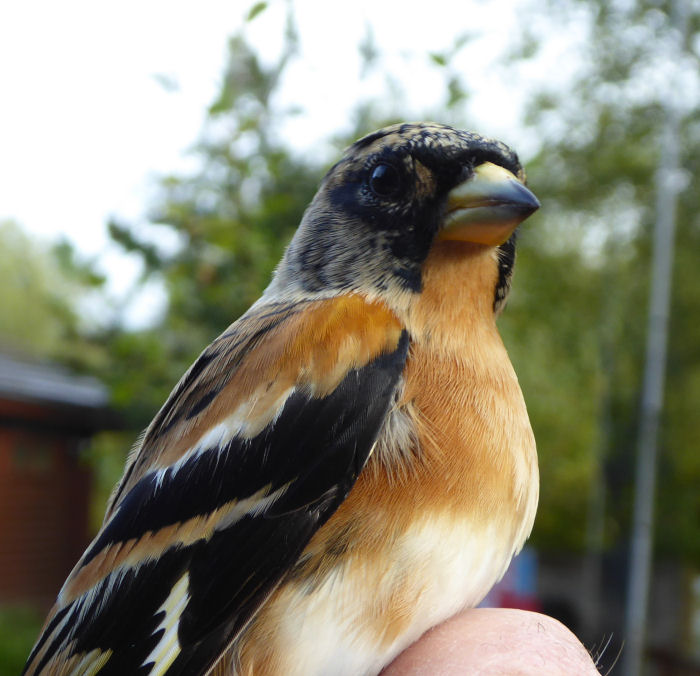
Also Redwing
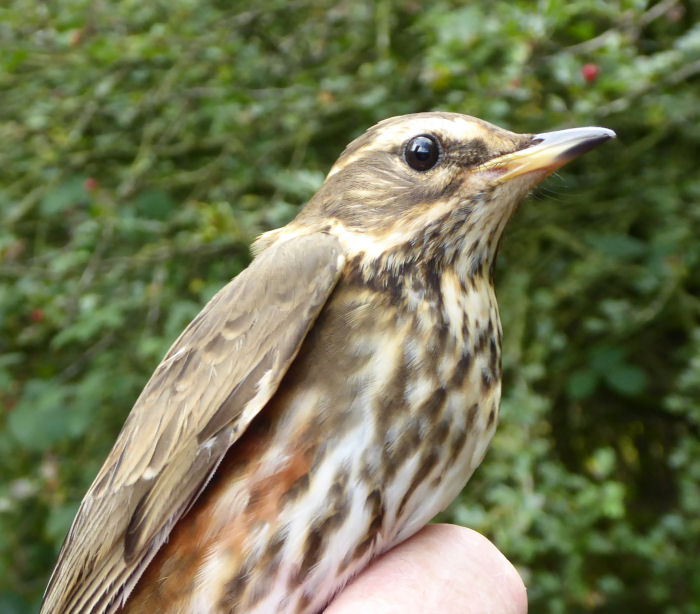
It has been reported that huge flocks are leaving Scandinavia.
Sunny Again
Monday, October 9th 2017
On guided walks you tend to have favourite stopping places depending on the season. This tree, full of berries, is one of mine in autumn and spring. In autumn because it is full of berries and in spring because it is still full of berries, except one year when I stopped to point this out - every single berry had gone!
It has a really good crop of berries so we will wait and see what happens next.

Ivy is just beginning to flower. The flowers provide much needed food for many insects at this time of year. As the insects flit from one flower to the next it is rather difficult to catch one on focus, but today Red Admirals were settling and feeding.

Common Darters were to be found in most sunny spots, but these two seemed to be passing the time of day at the Voley pond.

I can't resist taking photographs of oak leaves against a blue sky!

Change and the Same
Sunday, October 8th 2017
Knowing that you have a good photo of 'x' is one thing, but finding it is not an easy matter as your filing system leaves a little to be desired. On the other hand it does mean that you look back at many photos and say oh or ah or wow.
For those who have visted Foxglove over the years, can you remember the bridge being in place before the conifer block was cut down?

The view is a little different now.
.jpg)
The conifer block was felled.

Volunteers got wet, very, muddy even more so, when clearing the brash on worky days. A good fire was needed.

The area was replanted.

But some things stay the same. Volunteer Worky Days still need a fire or it is not a 'proper' Worky Day!

Common Toads visit our ponds every year in the spring.

Bird ringing continues through the year and Blue Tits are regular visitors to the ringing room.

Late summer flowers provide food for Peacock Butterflies.

Brimstone Butterfly caterpillars feed on Buckthorn and Alder Buckthorn. These trees have thrived over the last few years and the numbers of Brimstone Butterflies have increased.

Colours
Saturday, October 7th 2017
Spindle trees are changing colour.

Speckled Wood butterflies are still flitting around in the sunshine. They survive the winter as a caterpillar and a pupa, the only butterfly to do so.
.jpg)
There are still cream Angelica seed heads to be seen, which provide ideal places for spiders and small snails.

The willowherbs have dispersed all their seeds and only the cases are left now.

What a Difference
Friday, October 6th 2017
Looking through the photos taken over the last few days it is amazing the differences in the conditions. We have had rainbows.

We have had glorious sun over the moor.

We have had rather dramatic skies over the heath, caught by Leanne.


Regular readers of our blog will notice the new fence around the heath. Volunteers have spent hundreds of hours removing invasive species from this area, only to find that yet more have appeared almost overnight. After discussions with Natural England it was decided that the best way forward was to introduce Exmoor Ponies who will, we are told, eat the invasive species but hopefully, leave the heather alone to thrive.
Many reserves and conservation areas use Exmoor Ponies as part of their habitat management plans.
The ponies that were on our moor last year did a good job grazing much of the coarse vegetation.


The fenced areas of the heath are not large so they will be rotated around each section and if they do an excellent job and eat everything they should, they can then be taken to the moor. We hope that the ponies, not yet sure what they are called, will arrive about mid October.
A Sunny Volunteer Day
Friday, October 6th 2017
As summer leaves us, the work on the reserve changes. After checking that the recent winds had not brought down any trees or caused any other damge the volunteers set to work on removing some Sycamores that were in danger of encroaching onto the bridge to the easy access hide.
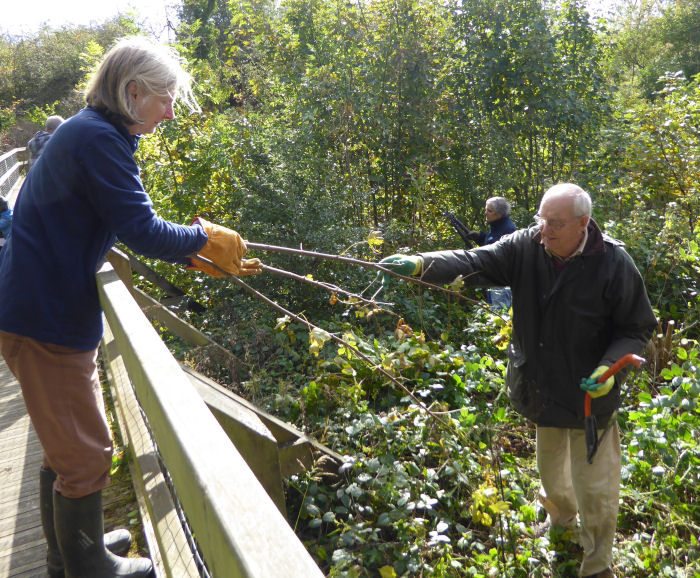
Some of our regular friends visited and enjoyed the warm sunshine and at times the cool wind!
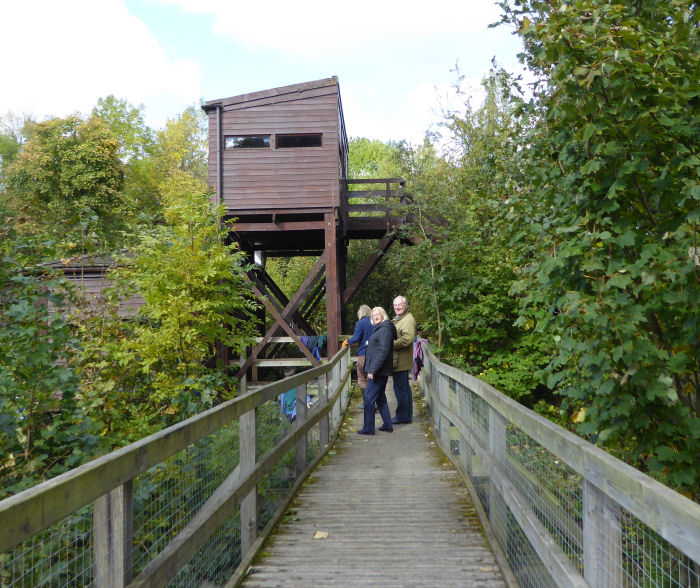
Tony and Mike checked water levels. The pipes leading from Risedale Beck to the ponds were blocked as were the overflow channels, so rather like the intrepid explorers of old they set off through the summer's good growth of vegetation, to improve the situation.
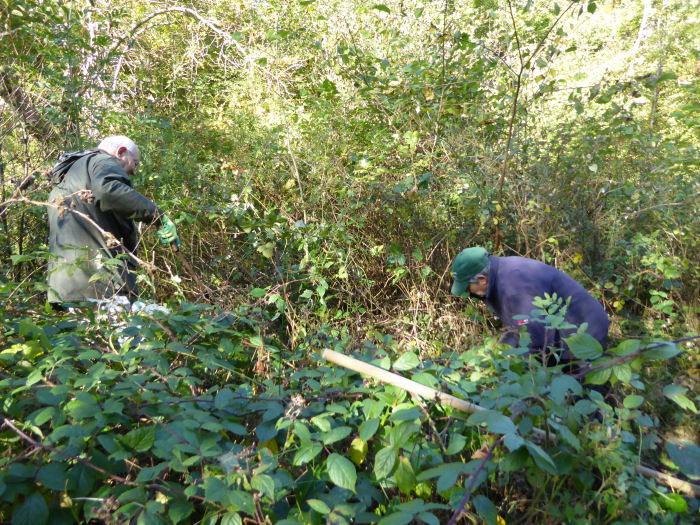
Whilst taking photographs a large leaf was noticed, on closer inspection, through the camera lens I hasten to add, it looks like a Water Lily leaf. This species is recorded on the species list from 1992, but to my knowledge has never been seen since. Interesting.
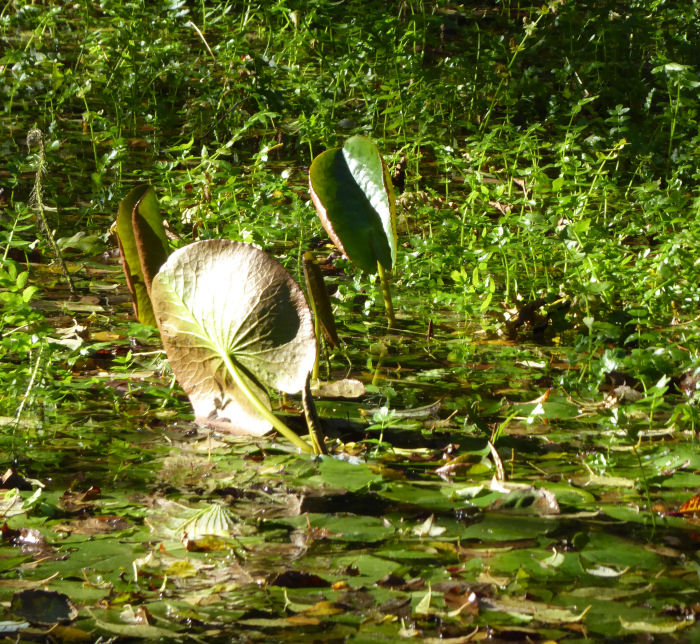
Thank you very much to all our volunteers who helped yesterday.
It is always special when you are the last to leave the reserve. It is quiet and peaceful and there is always that tingle of anticipation that you might just see something. Yesterday was no exception. A Kestrel was hunting over the heath. Wonder if it was one of 'ours'?
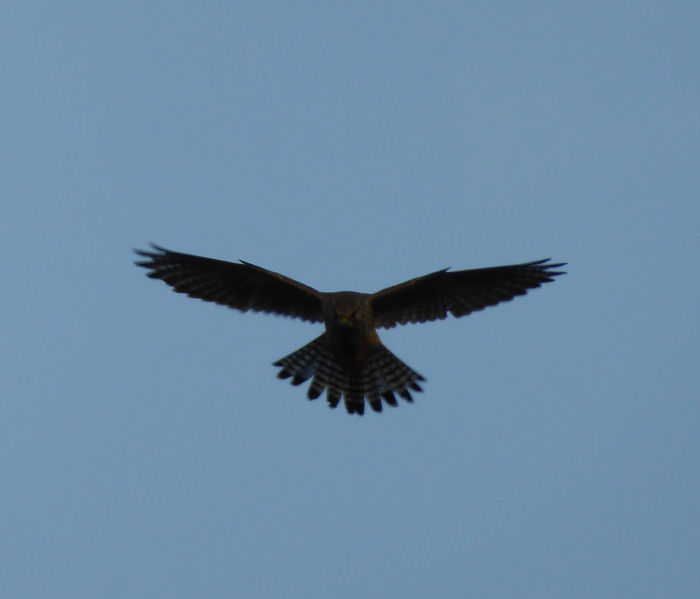
Autumn is Here
Wednesday, October 4th 2017
As you drive up the access road look for the Shaggy Ink Cap fungi growing all in a row. This is where we can normally find them, but not in such large numbers, all together.

You can see that this one has been eaten.

Out on the moorland, Dexter Cattle and Swaledale sheep are helping with our habitat management. Pauline checked on the cattle and the calf was very co-operative moving so she could get this lovely photo of her. I love her fringe!

Eventually modelling was just too much so she headed for Mum.

The Swaledales were not interested in posing for photographs.

Amazingly we found many flowers passing the flower test a week ago, but already their numbers are decreasing. Harebells can still be found sheltered and hidden away in the Gorse on the moor.

Devil's Bit Scabious is in flower, but the seed heads are now more obvious and so beautiful.

Hemp Agrimony that has fed so many bees and butterflies has now set seed showing off amazing patterns.

A Mixture
Sunday, October 1st 2017
When the seasons change it is easy to say on the blog - ' At this time of year ....' Well, at this time of year, early autumn, the species to be seen around the reserve depends on the weather. (We have said that before too!) If it is dull and cool then some flowers, seeds and the birds on the lake are the species to photograph.
The flower group recorded Honeysuckle in flower as well as its red fruits. Some fruits and seeds are readily eaten by birds and small mammals but I must admit I am not sure if anything eats these fruits.

There are still some Hardheads showing their purple heads and quite often an accompanying fly or bee is holding tight until it warms up a little.


Once the sun comes out and the temperature rises, so the invertebrates wake up to make the most of the warmth. All the ripples on the pond surface were caused by Whirligig Beetles doing their whirling around! One of these days I will get a good, in focus, photo of one of these beetles.

A bit more investigation is needed to find out more about this rather large wasp, that was enjoying the sunshine.

Over 2600 species have been recorded on the reserve and it still amazes me that we can find more. Whilst photographing the moths, in the sunshine, a shout to come and look at a ladybird like beetle. Well photographed, we ID'd it as a False Ladybird, Endomychus coccineus. Bob Marsh, the beetle specialist for the NYU, replied 'It is bit scarce these days but there are Yorkshire records - usually in fungi on cut ends of logs - that sort of habitat.' We were standing next to the large log pile outside the Field Centre.









